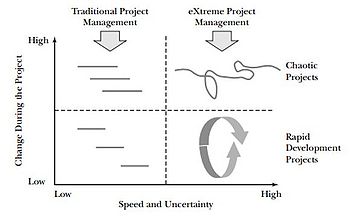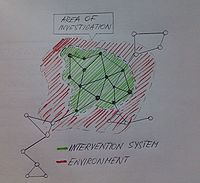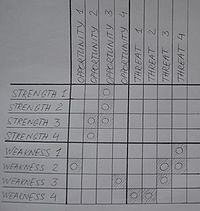Situation Analysis in Problem-Solving Cycle
Developed by Tomas Miskinis
The situation analysis is the first and crucial step in the problem solving cycle which leads to a broad basis of understanding of a situation. With this step starts search for goals and continues with defining and analysing the problem. It includes systematic collection and evaluation of economical, social, political and technological data which helps to identify external and internal factors that may affect the performance of any organization and its' choice of strategies. Moreover it aims at assessment of current and future strengths, weaknesses, opportunities and threats. The core of the situation analysis is composed of four basic approaches that are closely interrelated.[1] First approach is a system-oriented view which is used in order to structure the problem area. Next is cause-oriented view which helps to understand the situation and cause-effect relations of the problem. Then possible solutions and alternatives are provided within solution-oriented view and as a fourth approach to the future-oriented view brings all the listed ones previously at one point and shifts the perspectives from the present situation to the future with possible development opportunities. With the situation analysis is gained knowledge about the structure of the system which is going to be investigated together with its' features. Furthermore, project managers achieve list of present possible solutions and a more precise description of the problem. Basically there are four steps of the situation analysis and depending on the problem they could get different importance, thus it adapts to specific situation. The four steps are:
- task analysis
- analysis of the current state
- analysis of the future state
- summary of the problem and identification of actions to be taken [1]
Contents |
Task Analysis

The task analysis performance is where comprehensive overview is captured with basic knowledge of what is the task and what are the underlying problems, the cause and expectations. Thus this task analysis starts the definition of the project area. Therefore, the most proper way to start analysing the task is to begin with an approach towards problem identification. There are many different ways to identify the problem, but the three main aspects should be considered. [2] First of all, it should matter to any project manager to avoid the possibility to be blind-sided. Sometimes, simply they misinterpret or do not pay enough attention to warnings which evolves over time until it is too late to respond properly. A second most common mistake in problem identification is lack of recognition of how significant the issue is. That leads to not sufficient enough allocation of resources in order to solve it. The last, but not the least common error is overreaction. There is a need of accurate identification of possible crisis existence and thorough evaluation of situation. It means that sometimes people overreact in some situations and they assume to soon that it is a problem. So to avoid that it is recommended to evaluate situation and find out is it a real crisis or just a warning.
After the problem was identified and verified as many as possible facts about the situation must be collected. Finding out what is known helps to identify the purpose of the process and leads to exploration of what do the customers and stakeholders expect to receive as a delivery of the process. To ease the finding of the essence of the problem there are question check-lists provided (Fig.1) that analyse the task effectively and adapt to any specific circumstances. [1] Basically questions like what, why, how, who, where and when are stated and analysed. Nevertheless, involving the right and suitable people is a very important aspect in analysing the task too. It could be suggested to use Reginald Revans [3] approach of asking three main questions:
- Who knows? - about the situation and who has the relevant information.
- Who cares? - about solving this problem.
- Who can? - contribute and have competence solving this kind of problem.
In the end of the task analysis it should be clear what are capabilities of the task and in which environment it will be managed and also what will be the content and objectives of an analysis. In addition, within the procedure it is crucial to set up motivational aspects and reasonable mindset of carrying out any specific project.
Analysis of the Current State
Right after the task analysis a detailed investigation of the current state follows. This analysis phase involves gaining a comprehensive understanding of where the project or relevant problem is at present time so that it is possible to plan accordingly for moving from the current position to the desired results. There are usually these main steps of current state analysis:
- demarcate the system from its environment
- analysis of the system and the relevant fields of the environment
- identification of strengths and weaknesses of the system
- root cause analysis
Therefore, willing to obtain as accurate as possible position of the present situation it is desirable to review:
- the vision statement
- the mission statement
- the current strategic plan and goal attainment
- if relevant, the current alignment of strategic goals
- the projects hierarchy
- core competencies within the project [4]
Demarcate the System
In the analysis of the current state a system of demarcation is established providing information about relevant parties of the problem and mapping it in relation to each other. It is the most important step and it has a significant influence on the problem solving process. This helps to specify, communicate and adapt the scope of the project. Basically at this phase the considered system within which the problem is allocated has to be marked out from the environment in order to depict the boundaries where the changes and impact will take the place. This kind of simplified model also helps to communicate between interested and interrelated parties. There are three main parts distinguished in system demarcation model[1]:
- Intervention system - the area where the task is performed and corresponding interventions and changes are possible
- Environment - the rest of world outside the system, but still have the relevance to the problem solving
- Area of investigation - the area which includes the system itself and some other relevant and more important areas of the environment that could affect the defined system
In addition, there also can be excluded two more areas. The first one would be the area of effect where the effect of the solution could be expected and the second one would be the area of solution itself which defines more specifically part of intervention system that is directly used for the implementation of the solution. How big the system demarcation model will be mostly depends the scope of the task and clients vision, that is why it is recommended to demarcate the system with his participation. But the most important aspect is that relevant areas in the environment and the way they might influence the project must be identified. So it is always better at the beginning to try to design demarcation system as wide as possible in case to avoid the possibility to restrict the possible outcome of solutions. Later within the procedure and step by step evaluation the system narrows down to a more specific and critical area.
Principles to improve the process of the system demarcation
Black BoxThe black box perception is "the way scientific and technical work is made invisible by its own success. When a machine runs efficiently, when a matter of fact is settled, one need focus only on its inputs and outputs and not on its internal complexity." [5] The same insight can be used in project management when it is suitable to simplify the structure of the system, but still the elements and their affiliations are still open. In this way the input and output in solving the problem does not change, but the overall complexity is significantly reduced.
Alternative Points of View
When analysing the system it is a good practice to look at it from a different point of view. Thus, more outcomes can be accumulated and a combination of these would create more detailed and flexible overall picture. In this way even the same elements of the system can acquire different aspects when seen from a different angle. Therefore, such techniques as "Six Thinking Hats" [6] are used to look at decisions from a number of important perspectives.
System Hierarchy
This simply creates a step by step detailing of the system. Initially it can be started with previously mentioned Black Box from which gradually increases the level of detail and information provision. This helps to identify and manoeuvre more easily between the relations of different elements.
System and Environment Analysis
Further step in the analysis of the current state follows the consideration and evaluation of the interaction between current system and its environment. This gives a better perception of the whole structure, functions of each part and relations in between. Analysis of the system and the relevant areas of the environment is performed based on gathering the necessary data through comprehensive surveys and interviews, observations and research. All this is based on the previously composed demarcation system. The importance of this step should not be underestimated, because this is the point where crucial information is collected. Interviews should be smooth and to the point, in order not to loose the context of the problem and avoid stacking up with unnecessary data. The way of observation brings problem solver closer to the actual point of investigation what helps him to understand the situation by being involved and taking part in it. The other option is to make a research by collecting internal or external data. There are plenty of sources for data extraction starting with project reports and databases and finishing with available public information on the internet.
Strengths and Weaknesses
It is important to know what terms strengths and and weaknesses in this context mean:
Strengths - Internal factors that are favorable for achieving organization's objective.
Weaknesses - Internal factors that are unfavorable for achieving organization's objective.[7]
In order to perform evaluation of strengths and weaknesses of the current state requires a deep knowledge about what are circumstances and processes. It involves specifying the objective of the project and identifying the internal and external factors that are favourable or not to achieve that objective. Strengths and weaknesses can be identified within project's vision, mission and strategy. Here problem solver must be able to recognize the strong aspects of the project that would be a strong base for the future development and at the same time be aware of weaknesses that must be reduced or disarmed in order not to harm the project. As a result, identification of strengths and weaknesses supplement an understanding of the current state. At this point it could be visible how risky or how fortunate the project will be.
Root Cause Analysis
The root cause analysis sums up the analysis of the current state. It helps to identify the circumstances that resulted in the nature, the magnitude of it, the location and time of consequences of one or more events. With this knowledge is possible to identify what is supposed to be done or changed, what actions should be taken in order to prevent recurrence of similar harmful outcomes. One of the most common techniques used for the root cause analysis is "5 WHY". It simply states that when a problem occurs just ask why it occurred.[8] Asking the question "why" sufficiently enough times brings at the systemic cause of the problem. The results of the root cause analysis could be presented together with the strengths and weaknesses. Thus, both analysis supplement each other.
Analysis of Future State
Considering future state analysis it consists of prediction of environment behaviour and impact of this behaviour on the system. This is all more about trying to foresee the possible trends of the system and what actually it could bring in the future. Here should be deliberated all possible scenarios and developments of key factors. The careful evaluation of future developments and their impact on the current or future system is considered. It is important to mention that all this is still performed based on the system demarcation. Several methods are used for it and extrapolation of data is expected. Crucial point here would be prediction of the impact of the behaviour on the system which would include identification of opportunities and threats of problem solving. And finally, one of the last steps would be the systematic evaluation of the analysis of strengths, weaknesses, opportunities and threats. To do this SWOT analysis is used. The interaction between those four properties is under the loop at this point.
Predicting Behaviour of the Environment
This part of future analysis is quite complicated and sometimes only relies on the planners assumptions, based on individual experience or historical data. But nevertheless there are several methods which can help in forecasting and predicting the future behaviour.[1] First would be the survey method. In this case collection of information from past or present facts is conducted. Additionally, stakeholders' visions and opinions, knowledge are considered.
Second method would be the Scenario writing. Where thoughts about possible future development and the consequences of it are described. At this point is important to think about several alternative solutions and to be aware of best and worst case scenarios.
Third one would be Delphi method. Where the group of experts are asked to answer questionnaires in two or more rounds. After each round a summary of the experts' opinions by the third person is provided. After that experts revise their earlier answers. Following this iteration the range of answers decreases and in the end it suppose to converge to the only and correct answer. Thus the mean or median results are used for solutions.[9]
And the fourth method would be the Extrapolation of time series. In this case, time function is used in order to predict the desirable parameter. The data for extrapolating trends is taken only from desirable parameter and assumptions are based on the past developments. Then those assumptions are projected to the future according simple extrapolation method. So basically this kind of assumption is delivered from the historical data analysis of similar processes and expected the analogous outcome.
Opportunities and Threats
Analysis of opportunities and threats gives the perception of the changing environment and the possible impact of results. To be concise it is necessary to define what exactly is meant by the terms opportunities and threats.
Opportunities - External factors that are favorable for achieving organization's objective.
Threats - External factors that are unfavorable for achieving organization's objective.[7]
Having in mind what opportunities and threats has the system helps more accurately plan further problem solving cycle and having identified fields avoid complications, but utilize this knowledge and transform into success. To make this analysis more easier to use it could be supplemented with appropriate causes and possible actions. Then at one place you have all possible ways where the problem solving could lead.
SWOT Analysis
One of the last phase of situation analysis in problem solving cycle is SWOT analysis. It provides comprehensive evaluation of results and clear view of present and future perspectives. Using SWOT matrix the strengths and weaknesses together with opportunities and threats are listed and thorough interaction of individual strengths and weaknesses with the opportunities and threats can be examined. It presents visual picture, where strengths could provide opportunities and diminish the possible threats and on the other hand repairing weaknesses could lead to minimizing threats possibility and in some way use opportunities.
Using the SWOT analysis puts every aspect of the problem in more structured and systematic way where the areas of actions are identified. This is a popular and versatile tool, but a lot of subjective decisions are involved at each step. Therefore SWOT analysis should be used more as a guide rather than as a strict prescription and should be kept in mind that it is an iterative process.[7]
Summary of the Problem
It is appropriate to conclude the situation analysis with the provided summary, where finalized problem is described and focus area is identified. The most important results are provided in this phase briefly and actions to be taken are included. Main parts of the summary would be:
- definition of the problem to be solved on the basis of SWOT analysis
- description of the solutions
- determination of solution framework
- degree of freedom in searching for solutions
It should be ensured that an appropriate information is collected and provided for the further steps of problem solving cycle. The continuation should progress without overload of the information. As a final verification of situation analysis a short check-list could be used that would include fact that the problem is understood and needed actions are determined, that the objectives are defined and that the concepts synthesis with the first possible solutions could be started.
References
- ↑ 1.0 1.1 1.2 1.3 1.4 1.5 Züst R. and Troxler P. (2006). No More Muddling Through Mastering Complex Projects in Engineering and Management, Rotterdam: Springer.
- ↑ http://www.referenceforbusiness.com/management/Or-Pr/Problem-Solving.html
- ↑ Revans R. (1980). Action learning: New techniques for management. London: Blond & Briggs, Ltd.
- ↑ http://www.methodframeworks.com/article/critical-step-current-state-analysis-review-strategic-planning/index.html
- ↑ Bruno L. (1999) Pandora's hope: essays on the reality of science studies. Cambridge, Massachusetts: Harvard University Press.
- ↑ de Bono, Edward (1985). Six Thinking Hats: An Essential Approach to Business Management. Little, Brown, & Company.
- ↑ 7.0 7.1 7.2 http://www.free-management-ebooks.com/dldebk-pdf/fme-swot-analysis.pdf
- ↑ Scholtes P. R. (1998). The Leader's Handbook: Making Things Happen, Getting Things Done. The McGraw-Hill Companies, Inc.
- ↑ Rowe and Wright (1999): The Delphi technique as a forecasting tool: issues and analysis. International Journal of Forecasting.


